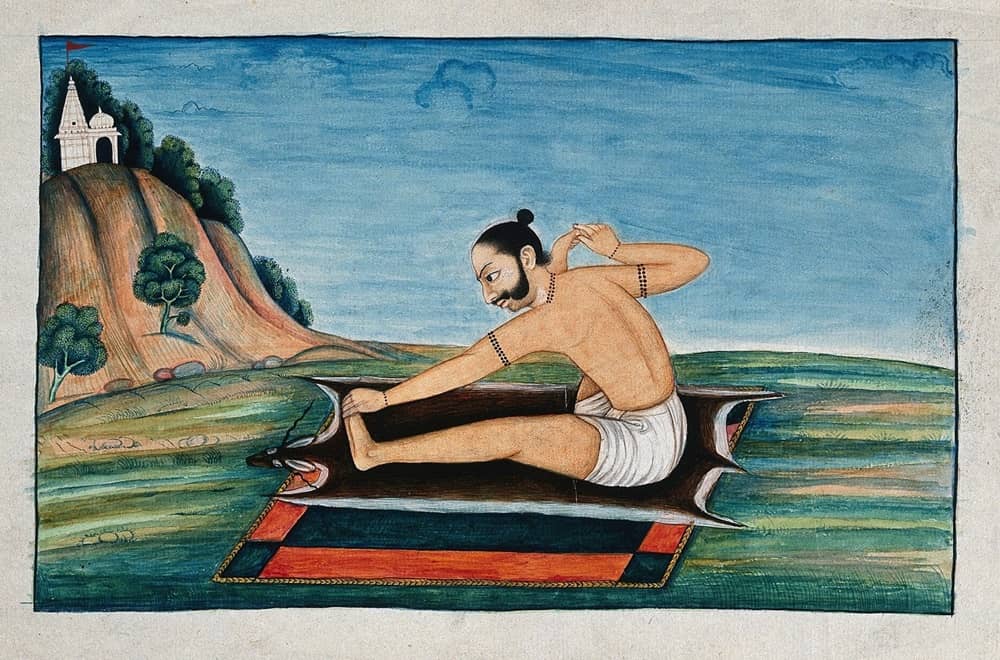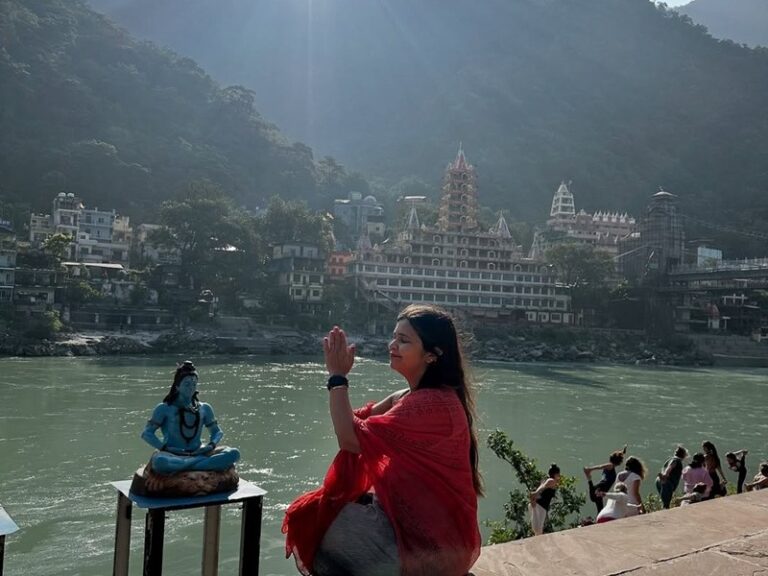Discover 40 most used Yoga Sanskrit Words in Asana Practice
If you’re drawn to the meanings of Yoga Sanskrit words, it likely means you’re exploring the depths of Indian spirituality or stepping deeper into your yoga journey. Sanskrit forms the sacred backbone of yogic philosophy, and understanding its key terms can add richness to your practice. Let’s uncover the essence of some foundational Sanskrit words you’ll often hear on the mat:
Here most important Yoga Sanskrit words and Sanskrit terms to know
1. OM (AUM)
Often called the sound of the universe, Om is considered the most sacred syllable in ancient Indian philosophy. In Sanskrit, it’s known as Pranava, which means “to hum.” Om is said to embody all other sounds and vibrations, making it an eternal, infinite resonance. Interestingly, similar sacred sounds like “Amen” in Christianity echo the vibration of Aum, symbolizing the universal connection across faiths.
2. Yoga (Yoh-gha)
The word Yoga comes from the Sanskrit root “Yuj,” meaning “to yoke” or “to unite.” At its core, yoga is the union of body, mind, and spirit—a bridge between the individual self and universal consciousness. Beyond just physical poses, yoga is a path to holistic well-being and spiritual awakening.
3. Asana (Ah-sun-ah)
Originally meaning “seat” in Sanskrit, Asana refers to the physical postures used in meditation and modern yoga practices. From Vinyasa and Ashtanga to Restorative and Bikram, all yoga poses fall under the umbrella of asanas. It’s the third limb of Patanjali’s Eight Limbs of Yoga, reminding us that yoga is much more than just movement—it’s a complete lifestyle.
4. Ahimsa (Ah-him-saah)
Translated as “nonviolence,” Ahimsa is a powerful concept rooted in love and compassion. Derived from “himsa” (to harm) and the prefix “a” (not), Ahimsa means “not causing harm.” It goes beyond physical nonviolence—it also means avoiding hurtful thoughts, words, or intentions. Practicing Ahimsa is embracing forgiveness, empathy, and universal love, making it a cornerstone of ethical yogic living.
Suggested Read: Discover Yoga Rishikesh India On the Ganges in the Himalayas

5. Dharma (Dhar-maa)
Dharma is a profound concept in Hinduism, Buddhism, and yogic philosophy, referring to the universal law or cosmic order that sustains life. To follow one’s Dharma is to live in alignment with one’s duty, truth, and purpose. It is one of the four pillars of life in Hindu thought, alongside Artha (prosperity), Kama (desire), and Moksha (liberation). Dharma legitimizes the values, ethics, and behavior that uphold harmony in both individual life and the greater world.
6. Ananda (Aah-nun-dhah)
Ananda means bliss, a state of pure joy and spiritual ecstasy. It’s more than just happiness—Ananda refers to an unshakable inner peace that arises from self-realization. Interestingly, Ananda was also the name of one of Buddha’s closest disciples, known for his sharp memory and devotion. You’ll often see the word attached to spiritual names, like Yogananda, meaning “bliss through yoga.”

7. Ashtanga (Ush-tung-ah)
The term Ashtanga has two important meanings in yogic tradition:
-
In practice, Ashtanga Yoga refers to a dynamic style developed in the 20th century by Sri K. Pattabhi Jois, involving a set sequence of postures synchronized with breath. Known for its intensity and structure, this style includes six progressive series, building strength, flexibility, and mental focus.
-
Etymologically, Ashtanga means “eight limbs” (Ashta = eight, Anga = limb), based on Patanjali’s Yoga Sutras, which outline the eightfold path to enlightenment—ranging from ethical conduct to meditation and spiritual absorption.
8. Avidya (Uh-vidh-yah)
Avidya is the Sanskrit word for ignorance, particularly spiritual ignorance. It signifies misconceptions, false knowledge, or an incomplete understanding of reality. In yogic philosophy, Avidya is considered the root of all suffering, as it veils our perception of truth and self-awareness. While different Indian traditions define it uniquely, all agree that Avidya distorts our view of the world and must be overcome to attain liberation.
9. Ayurveda (Ayur-vay-thah)
Ayurveda is India’s ancient system of holistic medicine, derived from the Sanskrit words Ayur (life) and Veda (knowledge). It teaches that mind and body are interconnected, and true healing comes from balancing the doshas—the natural energies of Vata, Pitta, and Kapha. Rooted in the Vedas, Ayurveda complements yoga beautifully, as both aim to maintain harmony and health through lifestyle, nutrition, and spiritual practices.

10. Bhakti (Bhuck-thee)
Bhakti means devotion—a deep, heartfelt surrender to the Divine. Stemming from the Sanskrit root bhaj (to adore), Bhakti Yoga is the path of love and devotional worship, where connection to a deity (like Krishna, Shiva, or the Divine Mother) leads to liberation. Often described as “love for love’s sake,” this path softens the ego and opens the heart, allowing the practitioner to dissolve into unconditional love and unity.
11. Brahma Nadi (bruk -mah nah -dee)
The Brahma Nadi is one of the most subtle and sacred energy channels (nadis) in the yogic system. In Sanskrit, brahma means “divine” or “sacred,” and nadi refers to a “channel” or “flow.” It resides within the central sushumna nadi, which runs along the spine, flanked by ida and pingala nadis. Some traditions describe the brahma nadi as the innermost pathway through which kundalini energy ascends, leading to spiritual awakening. It is believed to connect the major chakras, acting as a conduit for higher consciousness.
12. Chitta (chih -thah)
Chitta, from the Sanskrit root cit meaning “to perceive,” refers to the field of consciousness. It encompasses all thoughts, emotions, memories, and impressions—both conscious and unconscious. In yoga philosophy, mastering chitta is essential for attaining samadhi, the state of complete absorption and union with the Divine.
13. Chaturanga (chat-u-ranga)
Chaturanga Dandasana, commonly shortened to Chaturanga, is a foundational yoga posture that forms part of the Sun Salutation (Surya Namaskar). The pose involves lowering the body from a plank position until the elbows are bent at 90 degrees, maintaining a straight line from head to toe. It builds strength in the arms, core, and shoulders, and prepares the practitioner for deeper vinyasa flows. It literally translates as “four-limbed staff pose.”
14. Dhyana (dheeah -nah)
Dhyana means “meditation” in Sanskrit. It comes from the root words dhi (mind or intellect) and yana (movement), suggesting a flowing or focused movement of awareness inward. It is the seventh limb in Patanjali’s Eight Limbs of Yoga, and is seen as a deep, uninterrupted meditative state that precedes samadhi—the final stage of spiritual realization.
15. Dharana (dhaar -naa)
Dharana is the sixth limb of yoga as outlined in the Yoga Sutras of Patanjali. It means “concentration” and involves focusing the mind on a single object, such as a chakra, mantra, breath, or visual symbol. This mental focus helps in quieting the fluctuations of the mind (chitta vrittis) and sets the foundation for deeper meditative states (dhyana and samadhi).

16. Drishti (drish -tee)
Drishti means “gaze” or “focused vision.” It is a technique used in yoga and meditation to cultivate ekagrata (one-pointed focus). In physical yoga practice (asana), specific drishtis align with postures to deepen awareness, improve balance, and internalize energy. It is also linked to pratyahara, the fifth limb of yoga, as it encourages withdrawal from sensory distractions to enhance inner vision.
17. Guru (goo -roo)
In the yogic and spiritual context, a guru is more than a teacher—it is one who dispels darkness (gu = darkness, ru = remover). A guru guides the student (shishya) on the path of self-realization, offering knowledge, support, and insight. The guru-disciple relationship is considered sacred and central to many Indian traditions, and often marks a turning point in one’s spiritual evolution.
18. Japa (jah -pah)
Japa is the meditative repetition of a sacred word, sound, or mantra—either silently or aloud. Derived from the root jap, meaning “to mutter,” this practice is a form of devotional meditation that calms the mind and opens the heart. Often done with a mala (prayer beads), Japa yoga is believed to purify the consciousness and lead to samadhi—union with the Divine.
19. Jnana (gnyah -nah)
Jnana means “knowledge” or “wisdom” in Sanskrit. Jnana Yoga, the path of wisdom, is one of the four classical paths to spiritual liberation (moksha) in Hindu philosophy. It emphasizes deep self-inquiry, the study of scriptures (svadhyaya), and discernment between the real (sat) and the unreal (asat). It is considered the most intellectually demanding path, often pursued by seekers drawn to contemplation and understanding of the Self (Atman).
20. Kosha (koh-shah)
In Sanskrit, the term kosha means “covering” or “sheath,” and the koshas are referred to as the five sheaths. According to the Upanishads, these represent five levels of awareness, ranging from the physical body to the core of the self. Yoga practice helps individuals journey through these sheaths, fostering a deeper understanding of themselves and moving closer to their true Self.
21. Kundalini (koon-dah-lee-nee)
The word Kundalini, derived from Sanskrit, means “coiled one.” It refers to the primordial energy lying dormant at the base of the spine. Through yoga postures, breathing techniques, and meditation, one can awaken this energy, guiding it upwards through the seven chakras, ultimately reaching Sahasrara at the top of the head, bringing enlightenment.
22. Mantra (mun-thrah)
A mantra is a sacred sound, word, or phrase, used in various spiritual practices like yoga, Buddhism, and Hinduism. The word combines manas (meaning “mind”) and tra (meaning “tool”), suggesting that mantras are tools to focus and regulate the mind. Chanted with devotion, they are believed to create profound mental and spiritual effects.
23. Mandala (muun-dha-lah)
A mandala is a geometric design, often circular, symbolizing the cosmos. In Sanskrit, it means both “circle” and “essence.” Used in Buddhist and Hindu rituals, mandalas are powerful tools for meditation, helping practitioners focus their minds during spiritual exercises.
24. Mudra (mooh-dhrah)
Mudras are symbolic hand gestures used in yoga, Buddhism, Hinduism, and Jainism to control the flow of prana (life force). These gestures, of which there are believed to be 400, have specific meanings and effects on the body and mind, aiding in spiritual practice. Some mudras also involve the body (kaya) or consciousness (citta).
25. Namaste (nuh-muss-thay)
Namaste combines the Sanskrit words nama (“bow”) and te (“to you”). It translates to “I bow to you,” and represents a deep, spiritual recognition of the divine within another person. It’s a common greeting and gesture of respect, especially in yoga practice.
26. Prajna (prugh-nah)
Prajna, in Buddhism, signifies the highest form of wisdom or understanding. This state of awareness transcends ordinary perceptions and is reached through focused meditation and reflection, leading toward enlightenment and a deep understanding of the true nature of existence.
27. Prana (prah-nah)
In Sanskrit, prana refers to “life force” or “vital energy.” It is the universal energy present in both living and non-living things, and understanding and mastering prana is key in yogic philosophy. Yogis seek to enhance their health and well-being by focusing on this vital energy.
28. Pranayama (prah-nah-yah-mah)
Pranayama involves techniques for controlling and expanding prana through breath control. Derived from prana (“vital life force”), yama (“control”), and ayama (“extension”), pranayama is integral to yoga, aiming to balance and extend vital energy through conscious breathing.
29. Pratyahara (prut-yah-ha-rah)
Pratyahara is the practice of withdrawing the senses to enhance inner awareness. This step is crucial before advancing to deeper practices like dharana (concentration) and dhyana (meditation). The word combines prati (“against” or “withdraw”) and ahara (“food” or external influences), symbolizing the detachment from sensory distractions.
30. Samadhi (sum-ah-thee)
In yoga, samadhi is the final, highest state of consciousness, often described as enlightenment, liberation, or bliss. It marks the union of individual consciousness with universal consciousness, representing the culmination of the spiritual journey. Achieving samadhi brings profound self-realization and liberation from the cycle of birth and rebirth.
31. Samskara (sum-skah-rah)
Samskara refers to the subtle mental imprints from all past thoughts, actions, and intentions. These imprints shape a person’s behavior and character. The word comes from sam (“well thought out”) and kara (“action”), suggesting that conscious actions leave the deepest impressions.
32. Satya (sahth-yah)
Satya means “truth” in Sanskrit. In yogic philosophy, it is one of the yamas, or ethical guidelines, emphasizing the importance of being truthful in thought, speech, and action. Following satya leads to a life of integrity and spiritual clarity.
33. Shakti (shuck-thee)
In Hinduism, Shakti is the divine energy of creation and transformation. Often referred to as the Universal Mother, Shakti represents the dynamic force of the universe. Yogis who practice Tantra meditation seek to awaken this energy within themselves, recognizing it as a manifestation of the cosmos.
34. Sutra (soo-thrah)
A sutra is a concise, sacred text or verse in Hinduism and Buddhism. The word means “thread” or “code,” referring to the guidelines for spiritual practice. Sutras are often memorized and recited during meditation to deepen one’s understanding and connection to spiritual truths.
35. Swadhyaya (swahthee-yah-yah)
Swadhyaya refers to self-study or contemplation in Hinduism. The term combines sva (“self”) and adhyaya (“lesson”). This practice encourages individuals to reflect deeply on their thoughts, actions, and spiritual path, fostering self-awareness and growth.
36. Tapa (thah-pah)
Tapa refers to spiritual discipline that requires intense self-control, isolation, and periods of meditation. The root of the word, tap, means “to be hot,” symbolizing the inner fire needed to reach spiritual enlightenment.
37. Viveka (vih-vay-kah)
Viveka is the capacity to discern between what is real and what is unreal, permanent and transient. This discernment helps practitioners distinguish the self from external influences, facilitating the path to spiritual realization.
38. Yama (yah-mah)
Yama refers to ethical restraints and behaviors that are the first limb in Patanjali’s Yoga Sutras. These guidelines help yogis interact with the world in a moral and conscious way, promoting spiritual growth through actions like non-violence, truthfulness, and non-attachment.
39. Yantra (yahn-thrah)
A yantra is a mystical diagram used in meditation and worship. It is a type of mandala, representing the universe’s structure. In Tantric practices, yantras are believed to possess spiritual and occult powers.
40. SO HUM (so-hum)
SO HUM is a powerful mantra meaning “I am that,” connecting the practitioner to their innermost being. It’s used in meditation to fully accept and align with the present moment, promoting unity with the Self and the universe.
yoga sanskrit words yoga sanskrit words yoga sanskrit words yoga sanskrit words yoga sanskrit words yoga sanskrit words yoga sanskrit words yoga sanskrit words yoga sanskrit words yoga sanskrit words yoga sanskrit words yoga sanskrit words yoga sanskrit words yoga sanskrit words yoga sanskrit words yoga sanskrit words yoga sanskrit words yoga sanskrit words yoga sanskrit words yoga sanskrit words yoga sanskrit words yoga sanskrit words yoga sanskrit words yoga sanskrit words











